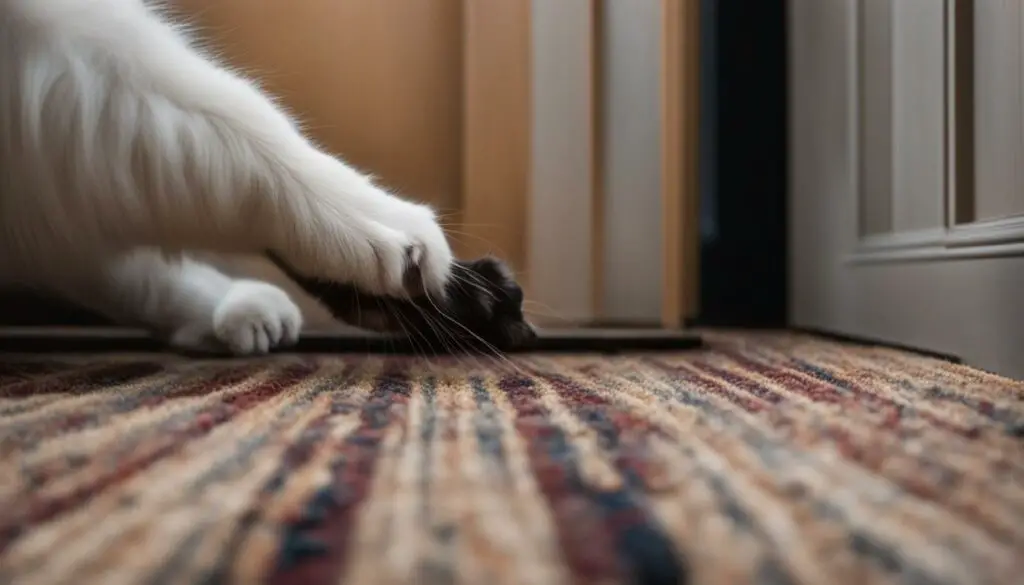As a cat owner, I understand the frustration and cost that comes with the destructive behavior of our feline friends. One common issue many cat owners face is when their cats tear up the carpet in front of the door. It’s important to explore why cats engage in this behavior and find effective solutions.
When it comes to cat behavior, understanding their natural instincts is key. Scratching, for example, is a natural behavior for cats that serves multiple purposes, including territorial marking and maintaining claw health. By scratching, cats leave visual and scent marks that communicate their ownership of an area.
Cats may tear up the carpet in front of the door for various reasons. It could be a way to mark their territory or a result of pent-up energy or stress. Some cats develop destructive habits if they don’t have appropriate outlets for their scratching instincts. Identifying the underlying cause of the behavior is crucial in finding effective solutions.
Preventing carpet destruction involves providing environmental enrichment and training. Offering a variety of cat furniture, like scratching posts and cat trees, gives cats alternative surfaces to scratch. Regular claw maintenance, such as trimming their claws or using claw caps, can also redirect their scratching behavior.
Protecting furniture from scratching is a crucial part of preventing carpet destruction. Using scratching deterrents like double-sided tape or bitter sprays can make surfaces unappealing to cats. Regular claw trimming minimizes damage from scratching and keeps their claws healthy.
Training techniques can also be employed to redirect a cat’s scratching behavior. Positive reinforcement, such as praising and rewarding the cat for using appropriate scratching surfaces, can encourage desired behavior. Providing enticing alternatives and making unwanted surfaces less accessible are effective strategies as well.
Addressing territorial marking involves creating a secure and comfortable environment for the cat. Using pheromone diffusers to reduce stress and providing regular play and affection can establish positive associations with their territory.
Preventing door scratching requires a combination of environmental modifications and behavioral training. Installing protective measures, such as a CarPET Scratch Stopper™, can create a barrier between the cat and the carpet. Providing alternative scratching surfaces and using positive reinforcement techniques further discourage door scratching behavior.
Cats may engage in destructive behavior, like tearing up the carpet, due to boredom or loneliness. Providing plenty of toys and opportunities for mental stimulation, like interactive toys and puzzle feeders, can alleviate these issues.
While some cat owners consider declawing as a solution, it is a controversial procedure that should be avoided if possible. Regular claw trimming and using soft nail caps are alternatives to prevent damage caused by scratching.
Managing fabric chewing and sucking, as well as preventing houseplant chewing, require providing alternative options and blocking access to hazardous items.
By understanding the reasons behind a cat’s behavior and implementing appropriate solutions, we can prevent carpet tearing in front of the door. Creating a harmonious home environment for both cats and their owners is achievable with environmental enrichment, redirected scratching behavior, and addressing underlying causes.
Key Takeaways:
- Cats tear up carpet in front of the door due to scratching behavior and territorial marking instincts.
- Understanding the reasons behind their behavior helps in finding effective solutions.
- Providing environmental enrichment, such as scratching posts and cat furniture, can redirect scratching behavior.
- Using scratching deterrents and regular claw maintenance protects furniture from damage.
- Positive reinforcement and making alternative surfaces more appealing help train cats to use appropriate scratching surfaces.
Understanding Cat Scratching Behavior
Cat scratching behavior is a natural and instinctual behavior that serves various purposes. By understanding why cats scratch, cat owners can find effective solutions to redirect this behavior and minimize carpet destruction. Scratching not only helps cats maintain the health of their claws but also serves as a way for them to mark their territory.
Scratching surfaces are an essential part of a cat’s environment. Cats will scratch on different surfaces, such as scratching posts, trees, furniture, or even carpets. Providing appropriate scratching surfaces can help redirect the behavior and protect valuable items in the home.
H3: The Benefits of Scratching Posts
Scratching posts are an effective tool to redirect cat scratching behavior. They provide cats with a dedicated surface for scratching, allowing them to fulfill their natural instincts without damaging furniture or carpets. Scratching posts come in a variety of sizes, materials, and designs, giving cat owners options to choose from based on their cat’s preferences.
| Benefit | Description |
|---|---|
| Prevents Carpet Destruction | By offering a scratching post, cats are less likely to scratch carpets or other inappropriate surfaces. |
| Provides Mental Stimulation | Scratching posts offer cats an engaging activity that helps keep them mentally stimulated and entertained. |
| Promotes Claw Health | Regular scratching on a post helps cats shed the outer layers of their claws, promoting healthy claw growth. |
| Reduces Stress | Having access to a scratching post allows cats to engage in natural behaviors, which can help reduce stress and anxiety. |
It is important to place scratching posts in strategic locations where cats are more likely to use them, such as near areas where they previously scratched. Placing them in high-traffic areas or near sleeping spots can also encourage their use. Regularly inspecting and maintaining the scratching post will ensure its effectiveness and longevity.
Causes of Carpet Destruction
Cats may display destructive behaviors such as scratching the carpet in front of the door for various reasons. Understanding the underlying causes of this behavior is essential in finding effective solutions to prevent further damage. The following factors contribute to carpet destruction:
- Door Scratching: Cats may scratch the carpet in front of the door as a way of marking their territory or expressing their frustration. This behavior is often seen in cats who feel threatened or anxious about their environment.
- Cat Scratching Furniture: If cats do not have appropriate outlets for their natural scratching instincts, they may resort to scratching the carpet. This behavior can be a result of boredom, lack of exercise, or inadequate scratching posts.
- Destructive Habits: Some cats develop destructive habits due to a lack of mental stimulation or environmental enrichment. Without proper outlets for their energy, cats may engage in destructive behaviors such as carpet destruction.
- Carpet Damage: Over time, the repeated scratching of the carpet can cause significant damage. This can result in frayed edges, torn fibers, and unsightly holes. Carpet replacement can be costly, making it important to address the behavior as soon as possible.
By identifying and addressing these underlying causes, cat owners can implement measures to prevent further carpet destruction and promote better behavior in their feline companions.
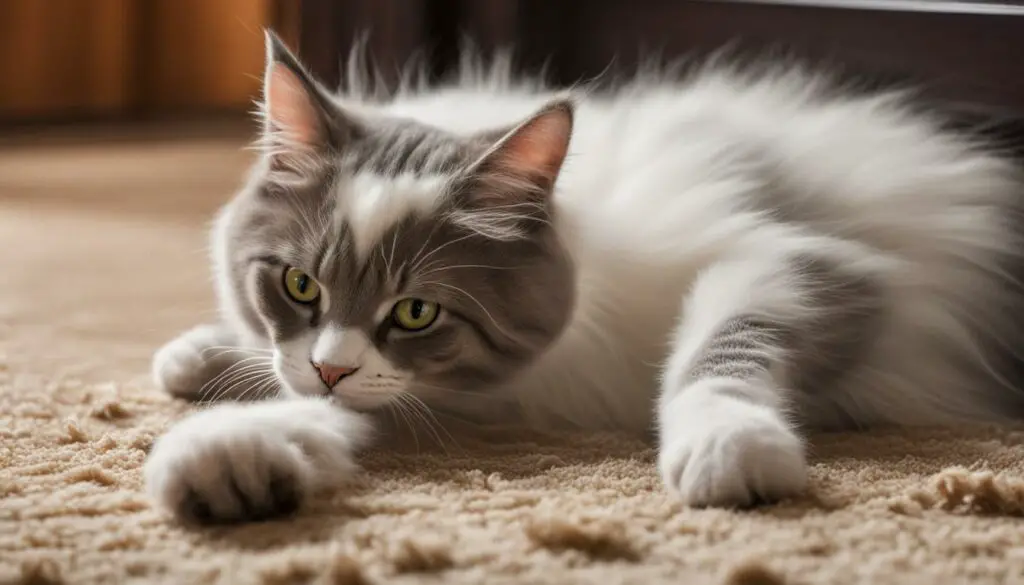
Environmental Enrichment and Cat Training
Providing environmental enrichment and training is crucial in redirecting your cat’s scratching behavior. By offering a variety of cat furniture, such as scratching posts, cat trees, and interactive toys, you can provide alternative surfaces for your cat to scratch. This not only satisfies their natural instincts but also helps to prevent carpet destruction.
Cat training plays a significant role in guiding your cat towards appropriate scratching habits. Use positive reinforcement techniques, such as praising and rewarding your cat when they use the designated scratching surfaces. This helps to reinforce the desired behavior and encourages them to continue using the appropriate outlets for their scratching needs.
Additionally, regular claw maintenance is essential in managing your cat’s scratching behavior. Trim their claws regularly to prevent excessive damage to your furniture and carpets. You can also consider using claw caps, which are soft covers that go over your cat’s claws, providing a protective barrier against scratching. These caps are safe and comfortable for your cat while effectively preventing damage to your home.
| Benefits of Environmental Enrichment and Cat Training | |
|---|---|
| Provides alternative scratching surfaces | Promotes healthy claw maintenance |
| Satisfies natural instincts | Prevents carpet destruction |
| Enhances mental stimulation | Guides cats towards appropriate scratching habits |
The Importance of Furniture Protection
When it comes to preventing carpet destruction caused by scratching behavior, furniture protection plays a crucial role. Cats have a natural instinct to scratch, and if their scratching needs are not met, they may turn to the nearest available surfaces, such as carpets and furniture. By implementing furniture protection measures, cat owners can effectively redirect their cats’ scratching behavior and maintain the integrity of their home.
One effective method of furniture protection is the use of scratching deterrents. These deterrents can make surfaces unappealing to cats, discouraging them from scratching. Double-sided tape is a popular option, as it provides an uncomfortable texture that cats dislike. Bitter sprays can also be used, as the taste discourages cats from scratching treated surfaces. By applying these deterrents to furniture and other vulnerable areas, cat owners can effectively protect their belongings.
Regular claw trimming is another important aspect of furniture protection. By keeping the cat’s claws trimmed, their ability to cause damage through scratching is reduced. Cat owners can learn how to trim their cat’s claws safely or enlist the help of a professional groomer or veterinarian. Additionally, for those who may be hesitant to trim their cat’s claws, alternative options such as soft nail caps can be applied to prevent scratching-related damage.
Table: Comparison of Scratching Deterrents
| Scratching Deterrent | Effectiveness | Ease of Use | Cost |
|---|---|---|---|
| Double-sided Tape | High | Easy | Low |
| Bitter Sprays | Moderate | Easy | Low |
Table shows a comparison of scratching deterrents based on their effectiveness, ease of use, and cost.
By prioritizing furniture protection, cat owners can create a harmonious living space where both cats and humans can coexist without the worry of carpet destruction. Through the use of scratching deterrents and regular claw trimming, cats can be redirected to appropriate scratching surfaces, preserving the condition of carpets and furniture and ensuring a comfortable home environment for everyone.
Training Techniques for Redirecting Scratching Behavior
When dealing with a cat’s scratching habits, it’s important to redirect their behavior to appropriate surfaces. With consistent training techniques, you can modify their scratching patterns and discourage the destructive behavior.
Positive Reinforcement
One effective method for training cats to use appropriate scratching surfaces is through positive reinforcement. Whenever your cat uses a scratching post or other designated surface, praise and reward them with treats or affection. This positive association encourages them to continue using the appropriate surfaces and deters them from scratching the carpet in front of the door.
Providing Enticing Alternatives
Another training technique is to provide enticing alternatives to redirect your cat’s scratching behavior. Experiment with different types of scratching surfaces, such as vertical posts, horizontal scratching pads, or sisal-covered furniture. Cats have individual preferences, so offering a variety of options can help you identify their preferred scratching surface.
Consider placing the alternative scratching surfaces near the areas where your cat tends to scratch the carpet. This helps divert their attention and encourages them to use the designated surfaces instead. Applying catnip or using pheromone sprays on the scratching posts can also make them more attractive to your cat.
Making Unwanted Surfaces Less Accessible
To further discourage your cat from scratching the carpet, make the unwanted surfaces less accessible. You can use barriers such as double-sided tape or aluminum foil to deter cats from scratching certain areas. Cats generally dislike the sticky texture or crinkling sound produced by these materials, which can discourage their scratching behavior.
Additionally, if your cat is scratching the carpet near the door, you can try blocking off the area temporarily using a baby gate or furniture. This limits their access to the carpet and encourages them to seek alternative scratching surfaces.
Summary
In summary, redirecting a cat’s scratching behavior requires training techniques that focus on positive reinforcement, providing enticing alternatives, and making unwanted surfaces less accessible. By consistently applying these techniques, you can modify your cat’s scratching patterns and prevent carpet destruction in front of the door.
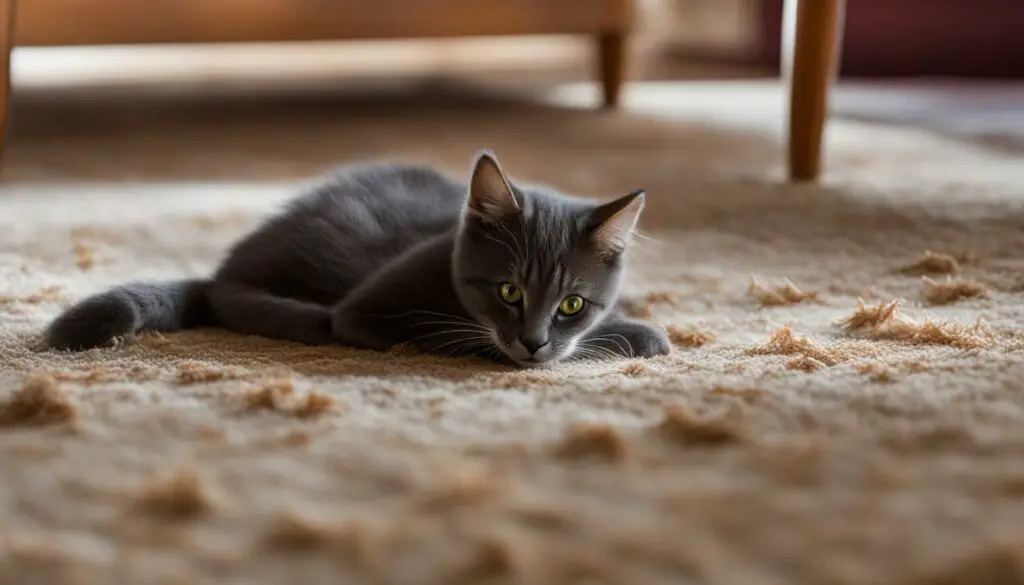
The Role of Cat Scratching Posts
When it comes to redirecting a cat’s scratching behavior, cat scratching posts play a vital role. These posts provide cats with a designated surface to scratch, helping to protect furniture and carpets from damage. Understanding the different alternatives available, proper placement, and effective usage of scratching posts is essential for their effectiveness.
Selection of Cat Scratching Posts
When selecting a cat scratching post, there are various factors to consider. One important aspect is the type of post. Some cats prefer vertical posts, while others prefer horizontal surfaces. Experimenting with both options can help determine which one your cat prefers. Additionally, the material of the scratching post also impacts its appeal. Common materials include sisal rope, corrugated cardboard, and carpet. Observing your cat’s preferences can guide you in selecting the most suitable material.
Placement and Importance of Scratching Posts
The placement of scratching posts is crucial for their usage. It is recommended to have at least one scratching post per cat in different areas of the house. Placing scratching posts near the areas where your cat tends to scratch, such as near doorways or furniture, can help redirect their attention. It is important to note that scratching posts should be positioned securely and provide stability to prevent tipping over during use.
Scratching posts play a vital role in promoting a cat’s physical and mental well-being. They provide an outlet for natural scratching instincts and help cats maintain healthy claws. Regular usage of scratching posts can also provide cats with exercise and stress relief. By offering alternative scratching surfaces, cat owners can effectively redirect their cat’s scratching behavior away from carpets and furniture, creating a harmonious living environment.
Addressing Territorial Marking
Addressing territorial marking in cats is essential to prevent carpet destruction in front of the door. Territorial marking is a natural behavior exhibited by cats to establish their boundaries and communicate with other felines. However, when it leads to destructive habits, it can become a problem for cat owners.
To address territorial marking, it is important to create a secure and comfortable environment for the cat. Providing hiding places, such as cat condos or shelves, can help the cat feel safe and reduce the need for marking. Additionally, utilizing pheromone diffusers, such as Feliway, can help reduce stress and anxiety, which are common triggers for territorial behavior.
In addition to environmental modifications, regular play and affection sessions are crucial to establish positive associations with the territory. Interactive play with toys and engaging in grooming sessions can help strengthen the bond between the cat and its surroundings, reducing the need for excessive marking.
| Addressing Territorial Marking | |
|---|---|
| Provide secure and comfortable hiding places | Reduce the need for marking |
| Use pheromone diffusers | Reduce stress and anxiety |
| Engage in regular play and affection sessions | Establish positive associations with the territory |
By implementing these strategies, cat owners can effectively manage territorial marking and prevent carpet destruction. It is important to remember that addressing territorial marking requires patience and consistency, as changing the cat’s behavior takes time. Consulting with a veterinarian or animal behaviorist may also provide further guidance on managing this behavior.
Tips for Preventing Door Scratching
Preventing door scratching is essential to protect your carpet and maintain a harmonious living space. By implementing a combination of environmental modifications and behavioral training, you can effectively discourage your cat from engaging in this destructive behavior. Here are some tips to help you prevent door scratching:
Create a Physical Barrier
Installing a protective barrier, such as a CarPET Scratch Stopper™, can create a physical deterrent between your cat and the carpet in front of the door. This barrier is designed to fit snugly against the bottom of the door and prevent your cat from accessing the area where it likes to scratch. It’s a simple and effective way to protect your carpet and redirect your cat’s scratching behavior.
Provide Alternative Scratching Surfaces
Cats have a natural instinct to scratch, so it’s important to provide them with appropriate scratching surfaces. Invest in a sturdy scratching post or a cat tree that offers different textures and heights. Place the scratching post near the door where your cat tends to scratch, encouraging it to use the post instead of the carpet. You can also sprinkle some catnip on the scratching post to make it more enticing.
Use Positive Reinforcement
Positive reinforcement techniques can be highly effective in redirecting your cat’s scratching behavior. When you catch your cat using the scratching post or a designated scratching surface, reward it with treats, praise, or playtime. This positive association will encourage your cat to continue using the appropriate surfaces and discourage it from scratching the carpet.
Remember, consistency is key when implementing these tips. It may take some time for your cat to adjust to the new scratching options, so be patient and persistent. With the right approach, you can successfully prevent door scratching and create a more cat-friendly environment in your home.
Dealing with Boredom and Loneliness
Cats are naturally curious and active creatures, and when they become bored or lonely, they may engage in destructive behaviors such as tearing up carpet or scratching furniture. To prevent these issues, it’s essential to provide cats with plenty of mental and physical stimulation. One effective way to combat boredom is to offer a variety of interactive cat toys. These toys can include puzzle feeders, which require the cat to work for their food, stimulating their natural hunting instincts and keeping them entertained for hours. Additionally, toys with feathers, bells, or catnip can provide endless fun and diversion for your feline friend.
Incorporating regular play sessions into your cat’s daily routine is also crucial in preventing boredom and destructive habits. Set aside dedicated time to engage in interactive play with your cat using toys such as laser pointers or wand toys. Engaging in play not only provides physical exercise but also strengthens the bond between you and your cat, reducing loneliness and promoting a sense of fulfillment.
Another way to address boredom is to create a stimulating environment. Consider setting up a cat tree or shelves that allow your cat to climb and explore different heights. This provides mental stimulation and gives them a sense of territory. Providing window perches or bird feeders near windows also allows cats to observe the outside world, keeping them entertained and engaged.
Preventing Destructive Behavior with Environmental Enrichment
Along with interactive toys and playtime, it’s crucial to ensure that your cat has a designated area for scratching. Investing in cat scratching furniture, such as scratching posts or boards, can redirect their scratching behavior away from your carpets and furniture. Place the scratching furniture in strategic locations throughout your home, including near the areas where your cat tends to engage in destructive behavior. Encourage your cat to use the scratching furniture by using positive reinforcement, such as treats or praise, when they scratch the appropriate surfaces.
By providing a stimulating environment, interactive toys, and designated scratching areas, you can help prevent boredom and destructive habits in your cat. Remember, a happy and mentally stimulated cat is less likely to engage in destructive behavior and more likely to be a well-behaved and satisfied companion.
| Benefits of Cat Toys and Playtime | Importance of Environmental Enrichment |
|---|---|
|
|
Alternatives to Declawing
Declawing is a controversial and unnecessary procedure that should be avoided if possible. It involves the removal of a cat’s claws, which can cause pain, discomfort, and behavioral issues. As a responsible cat owner, there are alternative options to consider when it comes to preventing damage caused by scratching.
One alternative to declawing is regular claw trimming. Trimming a cat’s claws helps keep them at a manageable length and reduces the likelihood of them causing damage to furniture or carpets. It’s important to use proper technique and tools when trimming claws to ensure the process is safe and comfortable for both you and your cat.
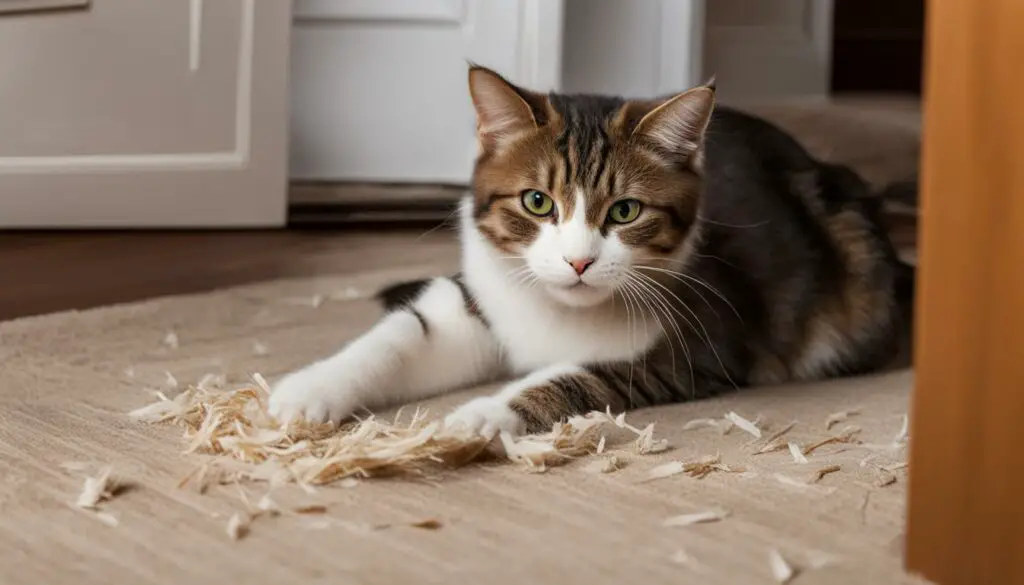
Another alternative is the use of soft nail caps. These caps are applied to the cat’s claws and provide a protective barrier between the claws and surfaces they come into contact with. Soft nail caps are safe and painless for cats and can be an effective way to prevent scratching damage.
It’s also important to provide appropriate outlets for your cat’s scratching behavior. Invest in a variety of scratching surfaces, such as scratching posts or cardboard scratchers, and place them strategically throughout your home. Encourage your cat to use these designated scratching areas by using positive reinforcement, such as treats or praise, when they engage with them.
By exploring alternatives to declawing and implementing preventative measures, you can protect your furniture and carpets while still ensuring your cat’s well-being and natural behaviors are respected.
Managing Fabric Chewing and Sucking
Some cats may develop a habit of chewing or sucking on fabric, which can be a comfort-seeking behavior or a result of curiosity. To manage this behavior, there are a few strategies that cat owners can employ.
- Provide alternative chewing options: To redirect your cat’s chewing behavior away from fabric, offer cat-safe rubber toys or dental chews. These can provide a safe outlet for their chewing instincts and help satisfy their oral fixation.
- Keep hazardous items out of reach: Ensure that any hazardous items, such as strings, buttons, or small objects, are kept securely out of your cat’s reach. This will help prevent them from ingesting anything that could be harmful.
- Give attention and affection: Sometimes, cats engage in fabric chewing or sucking behavior as a way to seek comfort or attention. By providing your cat with regular playtime, interactive toys, and plenty of affection, you can help address any underlying emotional needs.
It’s important to note that fabric chewing or sucking behavior can be a sign of stress or anxiety in some cats. If you notice excessive or compulsive chewing, it’s advisable to consult with a veterinarian or a feline behaviorist for further guidance.
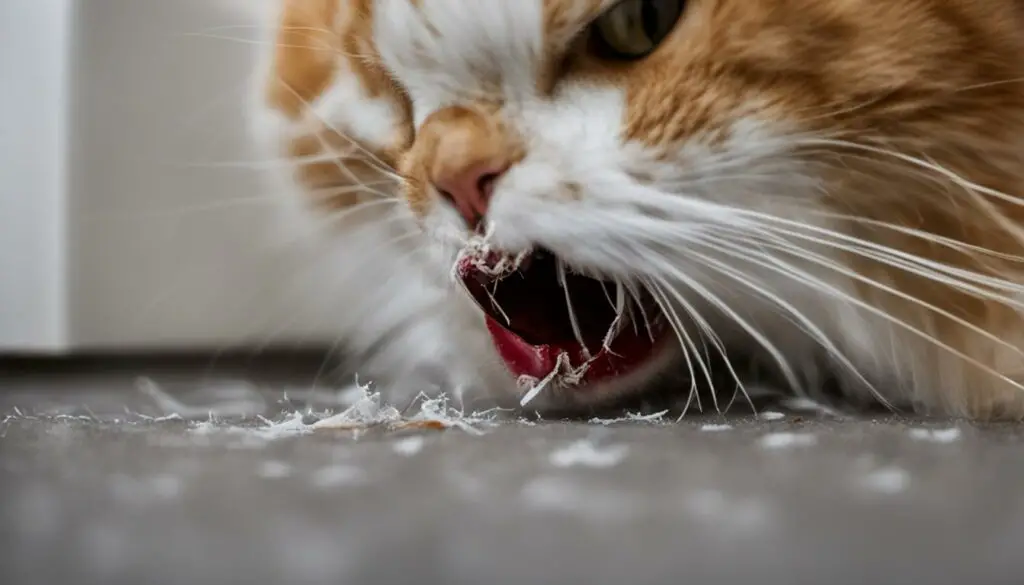
Alt tag: fabric chewing
Preventing Houseplant Chewing
Houseplant chewing is a common behavior in cats, but it can be problematic as some plants may be toxic to them. Understanding why cats engage in this behavior and taking preventative measures can help create a safe environment for both your cat and your plants.
Why do cats chew on houseplants?
Cats may chew on houseplants out of curiosity or as a natural instinct to seek out greens. Some plants also produce scents that are attractive to cats, further enticing them to nibble on leaves. However, it is important to note that not all plants are safe for cats to ingest. Some common houseplants, such as lilies, pothos, and philodendrons, can be toxic and cause digestive issues or even serious health problems.
Preventative measures for houseplant chewing
To prevent houseplant chewing, it is crucial to identify and remove any toxic plants from your home. Research the toxicity of different houseplants and choose cat-friendly alternatives. Additionally, you can consider the following measures:
- Place plants out of reach: Keep plants on high shelves or in hanging baskets to make them inaccessible to your cat.
- Provide cat-friendly alternatives: Offer your cat catnip or cat-friendly grass as an alternative chewing option.
- Use deterrents: Apply a pet-safe deterrent spray or place aluminum foil or double-sided tape around the base of plants to discourage chewing.
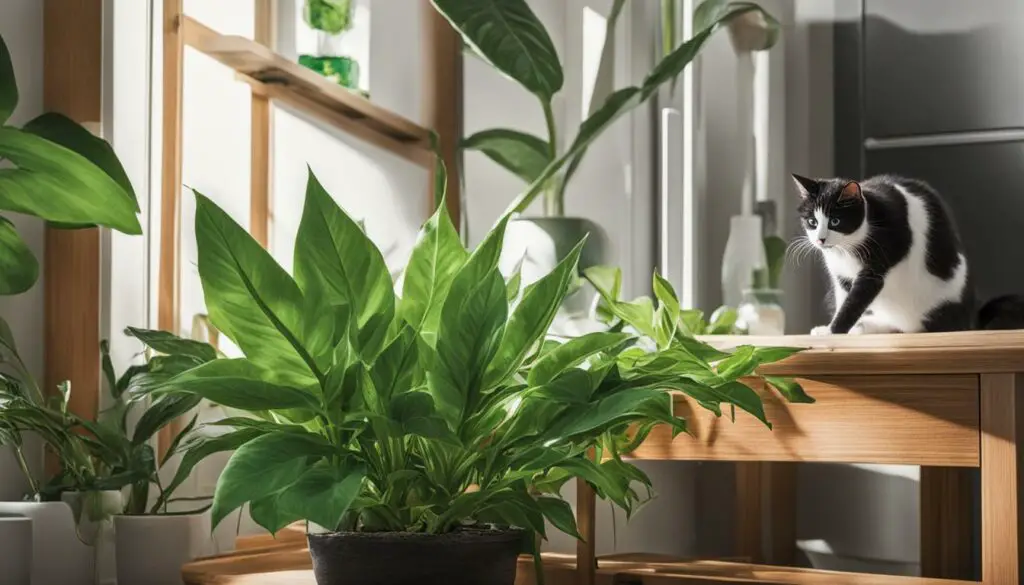
By implementing these measures, you can create an environment where both your houseplants and your feline friend can coexist peacefully. Remember to always prioritize your cat’s safety and well-being by ensuring their access to safe chewing options and removing any potentially toxic plants from their reach.
Conclusion
Understanding the reasons behind a cat’s behavior is crucial in addressing and preventing destructive actions, such as carpet tearing in front of the door. By delving into their natural instincts and providing appropriate solutions, cat owners can create a harmonious environment for both themselves and their feline companions.
Scratching is a natural behavior for cats, serving multiple purposes including marking territory and maintaining claw health. By understanding their motivations, cat owners can redirect scratching behavior to appropriate surfaces, such as scratching posts and cat trees.
Identifying the underlying causes of carpet destruction, such as territorial marking or lack of suitable scratching outlets, is essential in finding effective solutions. Through environmental enrichment, training techniques, and furniture protection measures, cat owners can minimize carpet destruction and promote positive behavior.
By implementing these strategies, cat owners can create a home environment that caters to their furry friends‘ natural instincts, preventing carpet tearing, and fostering a happy and healthy relationship between cats and their owners.
FAQ
Why is my cat tearing up the carpet in front of the door?
Cats may engage in carpet destruction for various reasons, including territorial marking, release of energy or stress, or a lack of appropriate scratching outlets.
How can I prevent my cat from tearing up the carpet?
Providing environmental enrichment, such as scratching posts and cat trees, can give cats alternative surfaces to scratch. Using scratching deterrents and regularly trimming the cat’s claws can also help redirect the behavior.
What should I do if my cat is scratching the door?
You can install protective measures, such as a CarPET Scratch Stopper™, to create a barrier between the cat and the carpet. Additionally, providing alternative scratching surfaces and using positive reinforcement techniques can discourage door scratching behavior.
Is declawing a solution to prevent carpet tearing?
Declawing is a controversial and unnecessary procedure. Instead, consider alternatives such as regular claw trimming or using soft nail caps to prevent damage caused by scratching.
How can I prevent my cat from chewing or sucking on fabric?
Providing alternative chewing options, such as cat-safe rubber toys, and keeping hazardous items out of the cat’s reach can help manage this behavior.
Why does my cat chew on houseplants?
Cats may chew on houseplants out of curiosity or a lack of access to greens. Blocking access to the plants and providing alternative options, such as cat-friendly grass or catnip, can help prevent houseplant chewing.
How can I understand and address my cat’s behavior?
Understanding the reasons behind your cat’s behavior and implementing appropriate solutions, such as environmental enrichment and training techniques, can effectively prevent carpet tearing and create a harmonious home environment for both you and your cat.
Source Links
- https://mehimandthecats.com/carpet-scratch-stopper-review/
- https://www.vet.cornell.edu/departments-centers-and-institutes/cornell-feline-health-center/health-information/feline-health-topics/feline-behavior-problems-destructive-behavior
- https://ask.metafilter.com/251123/My-cat-is-taking-out-its-frustration-on-the-carpet-How-do-I-stop-it

